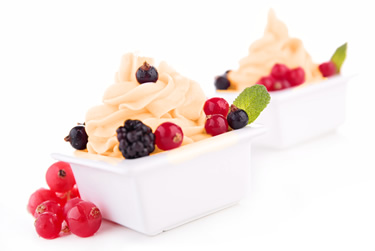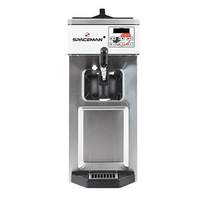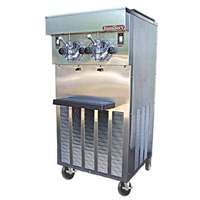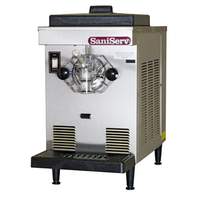America's love affair with soft serve ice cream has been around for decades, and while this treat is particularly refreshing on hot summer days, savvy foodservice operators know that it is an in-demand dessert all year long. If you are considering purchasing a soft serve ice cream machine for your restaurant, cafe, buffet or convenience store, there are a few important things to make note of.
Soft serve is a type of ice cream or frozen desert, such as yoghurt, custard, sorbet, that hasn't been hard frozen but instead is made by adding air to the ice cream mix, increasing its volume by up to 45%. The combination of higher temperature (around 18º F) and more air gives the ice cream a creamier consistency and makes it easy to dispense. The amount of air in soft-serve ice cream is called overrun. A soft-serve product with a 35% overrun has 35% air mixed into the liquid mixture as it freezes, so one 1 gallon of ice cream mix will yield 1.35 gallons of soft-serve ice cream.
Energy Efficiency
Soft serve ice cream machines work efficiently to freeze and add air (volume) to special liquid soft serve ice cream mixtures. Machines run at a temperature around 18 degrees Fahrenheit, keeping the ice cream not only frozen, but at proper storage temperatures. Because of this, these machines must run both day and night to prevent any changes in consistency or health code violations. To ensure minimal utility bills, look for energy-efficient models with the ENERGY STAR® seal.
Different Sizes
Smaller service operations that want to being offering soft serve ice cream often own modest counter-top machines, which allow an employee to refill and make new batches as needed. Buffet and sundae bars are usually self-service, and these operations typically purchase large, freestanding machines to maintain a higher volumes of ice cream. Larger machines, however, cost more to purchase, operate and maintain as well.
Features & Options
There are a variety of features and options that be examined when researching soft-serve ice cream machines:
- Soft serve Machines come with either a gravity-feed or a pressurized feed. Gravity-fed machines require staff to manually load liquid ice cream mix into a hopper located on top of the machines, and gravity does the rest. Pressurized machines use pumps to supply the freezing cylinder.
- The freezing cylinder and the dasher bar that mixes the product is at the heart of the soft-serve ice cream machine's functionality. Pay attention to your machine's design and how these two features work together.
- Newer machines can come with optional touch-pad LED displays to set temperature and consistency of the ice cream. Once set, the machine automatically adjusts to save time when switching mixtures.
- Some machines feature a safety mechanism to prevent compressor burnout. Some units shut down if no one responds to the alert within a certain amount of time, and others yet shoot hot refrigerant gas from the condenser to the barrel to keep it from freezing solidly when the mix is too low.
General Specs

- Applications:
-
Soft serve ice cream and desserts can be served straight up in a cone or bowl, or as a base for desserts such as banana spilts, milkshakes and rootbeer floats.
- Size:
-
Machines are available in counter top and floor models. Even footprints of large machines are relatively compact, with a high volume twin barrel machines being about 26" wide and 36" deep.
- Capacity:
-
As with many other types of equipment, one significant point to consider when selecting a soft serve machine is capacity. Machine capacity is measured in volume, either gallons per hour or servings per minute. Lower volume is generally 2-3 serving per minute, medium is 4-5 servings and high volume is 7 servings.
Style Capacity Serving Size Serving Per Minute Counter Top 7 Quart 4oz Serving 2-3 servings Counter Top 20 Quart 4oz Serving 3-7 servings Floor 20 Quart 4oz Serving 7 servings per drum - Features:
-
Soft serve machines are self-contained unit that will store mix, then churn and freeze it into ice cream, and dispense it. Recovery time is therefore important. If you require a medium or high volume machine for production, the machine must be able to freeze additional product to replenish what is being dispensed.
Gravity-fed machines require staff to manually load liquid ice cream mix into a hopper located on top of the machines, and gravity does the rest. Pressurized machines us pumps to supply the freezing cylinder.
Many models have touch pad LED displays to set the temperature and/or consistency of the final product. Once set, the machines automatically adjust for whichever mix is used.
Other controls include a low-mix light that indicates when it's time to replenish the mix hopper. Some models also have an audible signal to indicate when to add more mix. If the barrel isn't full, the mix can freeze solid, preventing the dasher bar from turning. A frozen cylinder can break the blades, bend the dasher bar, or burn out the compressor.
Several models have a safety mechanism to prevent compressor burnout. On some, the compressor automatically shuts down if you don't respond to the low-mix alarm within three minutes. The compressor will cycle every 10 minutes to keep the product cold until more mix is added. Other models shoot hot refrigerant gas from the condenser to the barrel to keep it from freezing solidly when the mix level is too low.
- Energy Source:
-
To ensure widespread compatibility with most foodservice situations, most smaller units run on single phase 115 volts and larger units 208-230 volts.
- Temperature Range:
-
A temperature-controlled machine allows the ice cream to dispense when it reaches a certain temperature, usually 18º F to 19º F. Many machines have a "night" or "sleep" switch that lets you conserve energy overnight, where permitted by local health codes. In this mode, the ice cream is allowed to thaw and be held at 38º F until you're ready to restart the machine.
- Construction:
-
The heart of all soft-serve machines is the barrel where the ice cream is produced. Each manufacturer uses its own design for both the freezing cylinder itself and the beater or dasher bar that mixes and pushes the ice cream to the dispensing head.
There are two types of dasher bar designs: low and high displacement. High-displacement beaters are typically designed for batch, hard-pack ice cream production. However, some manufacturers use them in soft-serve machines to improve the machine's efficiency.
Depending on the type of product you want to serve the dasher bar motor speed should be considered. If you plan to use a product with higher butterfat a higher rpm motor may churn the mix too much in the barrel.
Blades attached to the dasher bar scrape mix off the walls of the cylinder as it freezes. Most are made with some sort of plastic, however they do wear, and if worn blades leave frozen mix on the walls of the barrel, the machine will operate less and less efficiently.
To keep blades sharp some manufacturers have "self-sharpening" blades. Others attach blades to the dasher with a calibrated spring. That puts constant pressure on the blade as it wears to press it tightly against the cylinder wall. Blades typically need replacing every six months or so depending on volume. To indicate when a blade is ready to be replace some have wear lines to show employees when to change them. Others are designed to prevent employees from installing them improperly when they're cleaned or changed.
The power of any machine should match the kind of production you need for your operation. Dasher bar motors, for example, range from ½ hp and higher. Compressor motors start at 1 HP on small machines, while most machines have 2 HP compressors to quickly pull product from 38º F down to 18º F, and dispense cone after cone. Many models now use Scroll compressors, which are more energy-efficient than traditional compressor motors.
While these powerful components are in operation the machine is going to throw off a lot of heat. Since most soft-serve machines are located behind the counter or out in serving areas, that heat can affect both employees and customers in addition to how hard the machine itself works.
You have a few options on how to handle that heat.
- Air-cooled units offer placement flexibility as they don't require a water hook-up, only an electrical outlet. Allow about 3" of clearance around the entire machine, and plan to provide air conditioning to dissipate the heat from the compressor, dasher motor and condenser.
- Water-cooled machines are a good option if you buy a model that has a self-contained recirculating system so you're not paying for water to go down the drain. Alternatively, you can use the waste heat from the water that cools the soft-serve machine to heat water in the rest of your operation.
- Soft serve machines with a remote condenser, usually roof-mounted, will dissipate some of the heat outside. However, you must have a relatively short run to the roof for the refrigerant lines.
- Maintenance:
-
Since dairy products are susceptible to coliform bacteria, which can rapidly multiply to dangerous levels, many health departments require daily break down, cleaning and sanitizing of soft-serve machines daily. Before purchasing a soft serve machines, check with your local inspector or health department to know the rules for your area.
Several methods have been developed to ease the cleaning process, including washout kits, which are essentially faucet hookups for the top of the machine that enable you turn on the water straight into the hopper. Most suppliers also offer parts trays that give employees molded spaces in which to store parts as they disassemble and clean them. This helps employees track parts to properly reassemble the machine.
Other models have an auto-cleaning mode that flushes and cleans the machine innards at the push of a button. Even these models require disassembly periodically to clean and sanitize parts that may not get a thorough cleaning. Auto-cleaning can save employees a lot of time, and employers labor cost, if it significantly reduces the number of times the machine has to be stripped for cleaning.
- Certifications:
-
Units must be NSF listed under standard No.7, and UL Safety and UL Sanitation listed.
Have questions on purchasing a soft serve machine? Call the food service experts at ACityDiscount at 404-752-6715 for more information.




